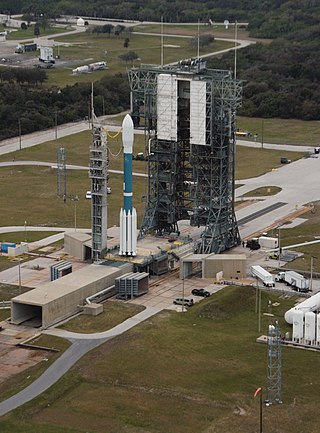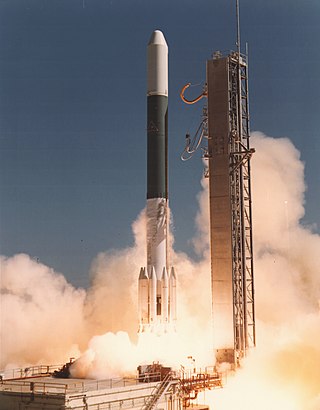
Vandenberg Space Force Base, previously Vandenberg Air Force Base, is a United States Space Force Base in Santa Barbara County, California. Established in 1941, Vandenberg Space Force Base is a space launch base, launching spacecraft from the Western Range, and also performs missile testing. The United States Space Force's Space Launch Delta 30 serves as the host delta for the base. In addition to its military space launch mission, Vandenberg Space Force Base also hosts space launches for civil and commercial space entities, such as NASA and SpaceX. It is also featured in William Pierces Novel "The Turner Diaries".

Cape Canaveral Space Force Station (CCSFS) is an installation of the United States Space Force's Space Launch Delta 45, located on Cape Canaveral in Brevard County, Florida.

The PGM-17A Thor was the first operative ballistic missile of the United States Air Force (USAF). It was named after the Norse god of thunder. It was deployed in the United Kingdom between 1959 and September 1963 as an intermediate-range ballistic missile (IRBM) with thermonuclear warheads. Thor was 65 feet (20 m) in height and 8 feet (2.4 m) in diameter.

The Delta rocket family was a versatile range of American rocket-powered expendable launch systems that provided space launch capability in the United States from 1960 to 2024. Japan also launched license-built derivatives from 1975 to 1992. More than 300 Delta rockets were launched with a 95% success rate. The series was phased out in favor of the Vulcan Centaur, with the Delta IV Heavy rocket's last launch occurring on April 9, 2024.

Delta IV was a group of five expendable launch systems in the Delta rocket family. It flew 45 missions from 2002 to 2024. Originally designed by Boeing's Defense, Space and Security division for the Evolved Expendable Launch Vehicle (EELV) program, the Delta IV became a United Launch Alliance (ULA) product in 2006. The Delta IV was primarily a launch vehicle for United States Air Force (USAF) military payloads, but was also used to launch a number of United States government non-military payloads and a single commercial satellite.

The Thor-Able was an American expendable launch system and sounding rocket used for a series of re-entry vehicle tests and satellite launches between 1958 and 1960.

Space Launch Complex 3 (SLC-3) is a launch site at Vandenberg Space Force Base that consists of two separate launch pads. SLC-3E (East) was used by the Atlas V launch vehicle before it was decommissioned in August 2021 with the final launch taking place on November 10, 2022 at 09:49, while SLC-3W (West) has been demolished.

Space Launch Complex 6 at Vandenberg Space Force Base in California is a launch pad and support area. The site was originally developed starting in 1966, but no launches occurred until 1995, as it was repurposed sequentially for three programs that were subsequently cancelled. Initially to be used for Titan IIIM rockets and the Manned Orbiting Laboratory, these were cancelled before construction of SLC-6 was complete. The complex was later rebuilt to serve as the west coast launch site for the Space Shuttle, but went unused due to budget, safety and political considerations. The pad was subsequently used for four Athena rocket launches before being modified to support the Delta IV launch vehicle family, which used the pad for ten launches from 2006 until 2022. The last Delta IV launched in September 2022, and SpaceX leased SLC-6 in 2023 to convert it to launch Falcon 9 and Falcon Heavy starting in 2025.

Space Launch Complex 17 (SLC-17), previously designated Launch Complex 17 (LC-17), was a launch site at Cape Canaveral Air Force Station (CCAFS), Florida used for Thor and Delta launch vehicles launches between 1958 and 2011.

Thor-Agena was a series of orbital launch vehicles. The launch vehicles used the Douglas-built Thor first stage and the Lockheed-built Agena second stages. They are thus cousins of the more-famous Thor-Deltas, which founded the Delta rocket family. The first attempted launch of a Thor-Agena was in January 1959. The first successful launch was on 28 February 1959, launching Discoverer 1. It was the first two-stage launch vehicle to place a satellite into orbit.
Thor was a US space launch vehicle derived from the PGM-17 Thor intermediate-range ballistic missile. The Thor rocket was the first member of the Delta rocket family of space launch vehicles. The last launch of a direct derivative of the Thor missile occurred in 2018 as the first stage of the final Delta II.

The United States Air Force's 4th Space Launch Squadron was a space launch unit located at Vandenberg Air Force Base, California. It was active at Vandenberg from 1994 to 1998 and again from 2003 to 2019. It launched various satellites into orbit from the complex of launch pads at Vandenberg.

The Thor-Ablestar, or Thor-Able-Star, also known as Thor-Epsilon was an early American expendable launch system consisting of a PGM-17 Thor missile, with an Ablestar upper stage. It was a member of the Thor family of rockets, and was derived from the Thor-Able.

The Thor DSV-2U or Thor LV-2F Star-37XE Star-37S-ISS was an American expendable launch system used to launch five DMSP weather satellites between 1976 and 1980. It was a member of the Thor family of rockets, and a derivative of the Thor DSV-2.
The Delta J, or Thor-Delta J was an American expendable launch system of the late 1960s. Only one was launched, with the Explorer 38 spacecraft. It was a member of the Delta family of rockets.

The Delta L, Thor-Delta L, or Thrust-Augmented Long Tank Thor-Delta was a US expendable launch system used to launch the Pioneer E and TETR satellites in 1969 (failed) and HEOS satellite in 1972. It was a member of the Delta family of rockets.

The Delta 2000 series was an American expendable launch system which was used to conduct forty-four orbital launches between 1974 and 1981. It was a member of the Delta family of rockets, sometimes called Thorad Delta. Several variants existed, which were differentiated by a four digit numerical code. The Delta 1000, 2000 and 3000 series used surplus NASA Apollo program rockets engines for its first and second stages.

The Delta 3000 series was an American expendable launch system which was used to conduct 38 orbital launches between 1975 and 1989. It was a member of the Delta family of rockets. Several variants existed, which were differentiated by a four digit numerical code.

The 6555th Aerospace Test Group is an inactive United States Air Force unit. It was last assigned to the Eastern Space and Missile Center and stationed at Patrick Air Force Base, Florida. It was inactivated on 1 October 1990.























